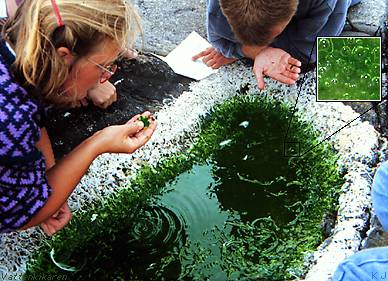 |
|
Eating above the surface
There are few animals that are able to eat when
the cliffs are left drained at low tide because they will have to expose
sensitive organs to the air and risk becaming dehydrated. To be able to
search for food and be able to eat at low tide, animals like periwinkles
need at least a moist surface under them. To accomplish this, they usually
eat in moist micro-environments, for example at night, in fog or rain or
when it is high tide. Mussels
and barnacles
on the other hand, have to be totally submerged because they catch their
food directly out of the water.
Algae do not need to eat, as they can produce their own food
with the aid of photosynthesis. To photosynthesise, they need energy in
the form of sunlight and certain bulding blocks such as carbon dioxide,
water and soluble
nutriants. Dehydration complicates photosynthesis as the needed building
blocks are fetched out of the water.

| Rockpools can be very advantageous for algae, for
example Enteromorpha
intestinalis. Sometimes, photosynthesis can be so intensive
that oxygen bubbles occurr, but circumstances can change quickly.
After a period of being left dry, the algae die and attain a white
colour. |
 |
Page 28 of
52 |
 |
|



